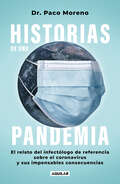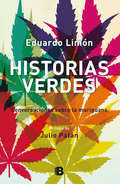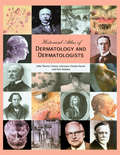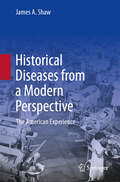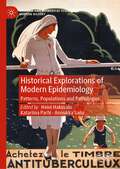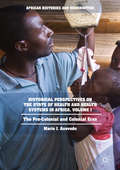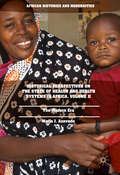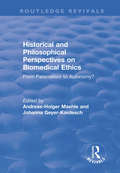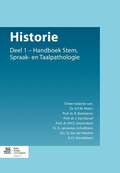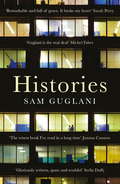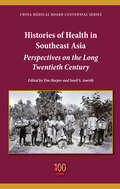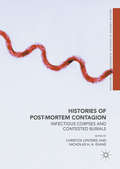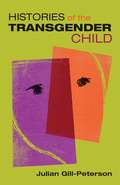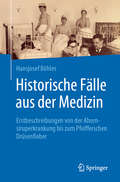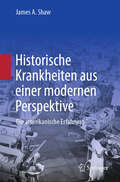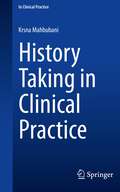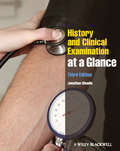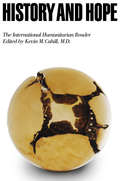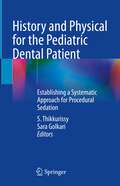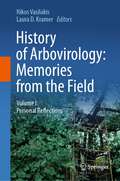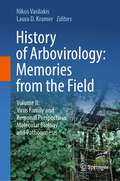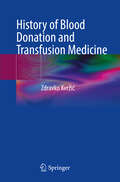- Table View
- List View
Historias de una pandemia: El relato del infectólogo de referencia sobre el coronavirus y sus impesansables consecuencias
by Paco Moreno"Paco, con su conocimiento y valentía, fue el infectólogo que a muchos nos trajo la luz en la oscuridad de esta pandemia. En este libro describe, con la claridad que lo caracteriza, lo que todos vivimos estos últimos años. Recomiendo su lectura ampliamente." -ARTURO ELIAS AYUR En diciembre de 2019 la noticia de una neumonía desconocida que asolaba a la ciudad china de Wuhan parecía un relato de ciencia ficción. Algunos meses más tarde, las es-cenas apocalípticas de metrópolis desiertas, hospitales desbordados y millones de personas confinadas se repetían por todo el mundo: era el inicio de la pandemia del coronavirus. El doctor e infectólogo Paco Moreno, quien estuvo en la primera línea de batalla contra este virus, fue un testigo privilegiado del avance devastador de la pandemia. Desde su trinchera, Moreno rescata historias de coraje y sobrevivencia, y también de quienesperdieron a sus seres queridos; de aquellos hombres de ciencia que, poniendo su vida en riesgo, no cesaron de buscar una cura; de aquellos errores políticos que se tradujeron en cientos de miles de muertes que pudieron haberse evitado. A la par, sus explicaciones en torno a las vacunas, el sistema inmunológico y el funcionamiento del virus, entre otras, enriquecen estas páginas. Pero fundamentalmente que-dan aquí los testimonios del espíritu humano ante la adversidad y lo desconocido, así como las reflexiones y enseñanzas que la pandemia nos ha dejado y que debemos atender si queremos un mejor futuro.
Historias del cerebro: La cocinera que perdió el olfato y la chica que no podía parar de correr
by Marcelo Merello Alejandra FolgaraitCasos curiosos presentados por un neurólogo. Las historias nos ayudan aconocer el lado desconocido de nuestro cerebro. El cerebro era un enigma hasta hace poco, cuando las neurocienciascomenzaron a tener mayor relevancia. Alejandra Folgarait y el neurólogoMarcelo Merello han escrito un libro apasionante sobre casos clínicosdonde el cerebro es el protagonista. Todas las historias estáninspiradas en pacientes que fueron tratados por el doctor Merellodurante los últimos veinticinco años. Cada caso comienza con ladescripción del síntoma y, como si se tratara de un detective privado,el médico estudia el asunto hasta llegar a un diagnóstico. Así conocemosal chico que pensaba que era Adrián Suar en Poliladron, la cocinera queperdió el olfato, la ex tenista que sufre de Parkinson y sale cada nochea revolver la basura, el ciego que ignoraba su ceguera, la camarera queno podía parar de hacer gestos obscenos, el hombre que golpea a su mujerentresueños, el ajedrecista que pasa las noches en vela jugando en sucomputadora y duerme con el CPU en la cama por miedo a que le espíen lasjugadas, la escribana que no puede parar de lavar y planchar ropa, elhombre que ve a su esposa fallecida sentada a los pies de la cama, lamujer que tenía un delirio erotomaníaco con Arturo Puig en Grande, pa oel juez que perdió los sustantivos para nombrar objetos.Historias del cerebro es un viaje cautivante a los rincones inhóspitosdel cerebro humano.
Historias verdes: Conversaciones sobre la mariguana
by Eduardo Limón¿Fumar o no fumar?, ésa es la cuestión a la que se enfrenta nuestra conciencia el día en que, por primera vez, se presenta ante nosotros la posibilidad de darse un "toque", o, más comúnmente dicho: un churro de mota. Escritores, músicos, científicos, promotores culturales y hasta tres dealers se dan cita en las páginas de Historias verdes para hablar del singular momento en que se encontraron con la mítica planta. Cada uno crea una crónica de su vida a partir de ese episodio; leer estos testimonios resulta pertinente frente al debate de la posible legalización de la mariguana en México. Eduardo Limón, periodista y escritor de gran trayectoria, conduce estas conversaciones y comparte algunas experiencias, y lejos de tomar una postura ante este polémico tema, apuesta por conciliar los gustos, las aversiones, los pros y contras en el consumo de la cannabis. Conversaciones con Fernando Rivera Calderón, Bef, Paco Ignacio Taibo II, Armando Vega-Gil, Joselo, Xavier Velasco, Ana Clavel, Fernanda Melchor, Ruzo, Juan Ramón de la Fuente y tres dealers. ¿Hay algo más humano que drogarse? FERNANDA MELCHOR Mariguana: un tema que dejó de ser prohibido y se volvió controvertido. JUAN RAMÓN DE L A FUENTE
Historical Atlas of Dermatology and Dermatologists
by John Thorne Crissey Lawrence C. Parish Karl HolubarRanging from the Egypt of the Pharaohs to the present day, Historical Atlas of Dermatology and Dermatologists offers a unique insight into the history of dermatology and the influences that led to present practice. It sheds new light on the emergence of dermatology as a separate medical speciality and on some of the key players who have contributed
Historical Diseases from a Modern Perspective: The American Experience
by James A. ShawHistorical Diseases from a Modern Perspective: The American Experience is a must read for any student of history or fan of historical novels. Every disease section contains fascinating historical insights relevant to the American experience, including how the 1900 outbreak of plague in San Franciso was contained, why the flow of the Chicago River was reversed, why “chicken pox parties” were once common, how the scourge of yellow fever was abated, and why poor southerners were once considered lazy and shiftless. Those readers interested in military history will learn how smallpox impacted troop strength in the Revolutionary War, dysentery in the Civil War, influenza in WWI, malaria in WWII, and sexually transmitted diseases across all wars. The social history of alcohol and opioid use is outlined as is the pre-antibiotic treatment of syphilis and gonorrhea, giving rise to the quip, “A night with Venus and a lifetime with mercury,” and the nickname “clap.”The use of anthrax as a tool of bioterrorism, the debilitating effects of scurvy, and the horror of leprosy are all discussed, along with multiple other diseases of historical interest. The text begins by outlining historical theories of disease causation, prevention and cure, to provide a contextual understanding for the reader. The ensuing chapters describe how historical diseases acquired their traditional monikers (Spanish flu, ship fever, ague, blue death, breakbone fever, scarlet fever, etc.) and how they were treated before the era of modern medicine. Emphasis is placed on the impact of disease outbreaks on society and how the understanding, treatment, and prevention of these diseases developed over time. The threat of historical disease reemergence due to waning vaccine immunities, vaccine hesitancy, antibiotic resistance and climate change is noted as a subtext throughout the book – a peril of global concern at this time. The book covers a large array of historical diseases, grouped for clarity and understanding within the broad categories of contagious diseases, vector-borne/zoonotic diseases, fecal-oral diseases, sexually transmitted diseases, substance use disorders, parasitic diseases, nutritional diseases, fungal diseases, and soil-related bacterial diseases.
Historical Explorations of Modern Epidemiology: Patterns, Populations and Pathologies (Medicine and Biomedical Sciences in Modern History)
by Heini Hakosalo Katariina Parhi Annukka SailoThis volume explores the history of epidemiology from the mid-twentieth century to the present. Epidemiology has exerted major influence on the way that both infectious and chronic diseases are conceptualized and controlled, and, more generally, on the way that people in modern societies think about health, behavior, longevity, and risk. This collection consists of a series of in-depth analyses of the roots, development, and impact of epidemiological research, illuminating the complex relationship between medical research and data on the one hand, and social and cultural factors on the other. The thematical and geographical scope of the book ranges from indigenous and participant perspectives to the visualization of pandemics, and from Circumpolar North to East Africa. The book identifies significant historical changes and the driving forces behind them, charting forms of science-society interaction that characterize modern epidemiology. Chapter 1 and chapter 4 are available open access under a Creative Commons Attribution 4.0 International License via link.springer.com.
Historical Foundations of Liver Surgery
by Daniel Azoulay Thomas S. HellingFor the surgeon of antiquity the liver has been an organ of mystery – and danger. Attempts to repair its wounds or remove tumors were fraught with hemorrhage and often a fatal outcome. Most forays were those to remove easily accessible tumors on the liver edge, but bleeding was a feared consequence still and surgeons wielded a plucky fortitude to take on even those. Not until the mid-20th Century were surgeons able to safely excise neoplasms that lay deep within the liver substance. Jean-Louis Lortat-Jacob achieved notoriety in his famous Paris hepatectomy of 1951 but he was not the first. That distinction may have belonged to German Professor Walther Wendel in 1910 or to Japanese surgeon Ichio Honjo who reported his operation in 1950, but in Japanese. It was not picked up by the Western surgical community until 1955. Names such as Hugo Rex, James Cantlie, Jean-Louis Lortat-Jacob, Tôn Thất Tùng, Jacques Hepp, Claude Couinaud, Henri Bismuth, Thomas Starzl, Roy Calne, and a host of others highlight the extraordinary curiosity, tenacity, and skill of those surgeons who broached unknown territory to master understanding and techniques of manipulation, resection, and transplantation that were formerly considered unapproachable by the surgical world.
Historical Perspectives on the State of Health and Health Systems in Africa, Volume I
by Mario J. AzevedoThis book examines the historical and current state of health and the health of the African people, including the Arab North, impacted by such factors as geography and natural elements, cultural and colonial traditions, and competing biomedical and traditional systems. It also looks at technological advances, poverty and health disparities, utilization of resources, and international presence, as reflected by the work of the World Health Organization, and structural adjustments imposed by the IMF and the World Bank.
Historical Perspectives on the State of Health and Health Systems in Africa, Volume II
by Mario J. AzevedoThis book focuses on Africa's challenges, achievements, and failures over the past several centuries using an interdisciplinary approach that combines theory and fact and evidence-based practices and interventions in public health, and argues that most of the health problems in Africa are not a result of scarce or lack of resources, but of the misconceived and misplaced priorities that have left the continent behind every other on the globe in terms of health, education, and equitable distribution of opportunities and access to (quality) health as agreed by the United Nations member states at Alma-Ata in 1978.
Historical and Philosophical Perspectives on Biomedical Ethics: From Paternalism to Autonomy? (Routledge Revivals)
by Andreas-Holger Maehle Johanna Geyer-KordeschThis title was first published in 2002: This volume discusses the subject of biomedical ethics. Various views, historical and contemporary, are discussed, with the editors using the contrasting concepts in the shift from paternalism to autonomy in 20th-century medicine as a heuristic tool for the critical study of ethics in medicine.As far as the evidence in this volume goes, paternalistic medical practices and patient autonomy had an uneasy relationship by the beginning of the 20th century. A hundred years later, full autonomy in decisions on medical treatment is still subject to numerous caveats. The text pays close attention to the interplay between various players, noting how factors such as social contexts, governmental organizations and the biotechnological industry influence and shape responses to the principle of bioethics.
Historie: Deel 1 - Handboek Stem-, Spraak- en Taalpathologie
by H.F.M Peters R. Bastiaanse J. Borsel P.H.O. Dejonckere K. Jansonius-Schultheiss Sj. Meulen B.J.E. MondelaersHet Handboek Stem-Spraak-Taalpathologie verscheen tussen 1997 en 2007 gefaseerd in losse afleveringen. Daarin werd alle kennis op het gebied van de stem-, spraak- en taalpathologie vanuit verschillende disciplines samengebracht. Het Handboek is bestemd voor iedereen die klinisch-praktisch of meer theoretisch is geïnteresseerd, of vanuit een ander vakgebied hiermee in aanraking komt. Voor logopedisten, artsen, linguïsten, spraak- en taalpathologen, audiologen, pedagogen en psychologen in Nederland en België is het Handboek een onmisbare vraagbaak.Deel 1 bevat een overzicht van de geschiedenis van de stem-, spraak- en taalpathologie.
Histories
by Sam Guglani'Guglani is the real deal' Michel Faber'Profound . . . Poetic . . . Humane' Gabriel Weston'Shows rare skill . . . Power and fear and morality' Sarah Moss, author of The Tidal Zone'Tender . . . designed to break your heart, mend it, then break it all over again' Rory Gleeson, author of Rockadoon ShoreHistories is a hypnotic portrait of life in one hospital, over one week. In the corridors and consulting rooms, by the bedside, through the open curtain, we witness charged encounters within the emotional and physical world of medicine. Old insecurities surface as junior doctors try to save a man from dying; an enraged chaplain picks a fight with a consultant; a porter waxes lyrical on his invisibility. These are only some of the stories that so seamlessly connect, collide and create an unforgettable panorama of being. Sam Guglani's vivid prose has the raw intensity of poetry that pulls the reader in on every page.
Histories of Health in Southeast Asia: Perspectives on the Long Twentieth Century (China Medical Board Centennial Series)
by Tim Harper and Sunil S. AmrithHealth patterns in Southeast Asia have changed profoundly over the past century. In that period, epidemic and chronic diseases, environmental transformations, and international health institutions have created new connections within the region and the increased interdependence of Southeast Asia with China and India. In this volume leading scholars provide a new approach to the history of health in Southeast Asia. Framed by a series of synoptic pieces on the "Landscapes of Health" in Southeast Asia in 1914, 1950, and 2014 the essays interweave local, national, and regional perspectives. They range from studies of long-term processes such as changing epidemics, mortality and aging, and environmental history to detailed accounts of particular episodes: the global cholera epidemic and the hajj, the influenza epidemic of 1918, WWII, and natural disasters. The writers also examine state policy on healthcare and the influence of organizations, from NGOs such as the China Medical Board and the Rockefeller Foundation to grassroots organizations in Thailand, Indonesia, and the Philippines.
Histories of Post-Mortem Contagion: Infectious Corpses And Contested Burials (Medicine And Biomedical Sciences In Modern History Ser.)
by Christos Lynteris Nicholas H A EvansThis edited volume draws historians, anthropologists and archaeologists together to explore the contested worlds of epidemic corpses and their disposal. Why are burials so frequently at the center of disagreement, recrimination and protest during epidemics? Why are the human corpses produced in the course of infectious disease outbreaks seen as dangerous, not just to the living, but also to the continued existence of society and civilization? Examining cases from the Black Death to Ebola, contributors challenge the predominant idea that a single, universal framework of contagion can explain the political, social and cultural importance and impact of the epidemic corpse.
Histories of Suicide
by David Wright John WeaverSuicide is one of the leading causes of death worldwide, with more than one million fatalities each year. During the post-war period, the rate of completed suicides has risen dramatically, especially among young men and Aboriginal peoples living in the Western world. While this has naturally led to growing concern amongst health care practitioners and policy experts, relatively little is known about the history of attempted and completed suicide. Histories of Suicide is the first book to examine the history of suicide in diverse national contexts, including Japan, Scotland, Australia, Soviet Russia, Peru, United States, France, South Africa, and Canada, to reveal the different social, political, economic, and cultural factors that inform our understanding of suicide. This interdisciplinary collection of essays assembles historians, health economists, anthropologists, and sociologists, who examine the history of suicide from a variety of approaches to provide crucial insight into how suicide differs across nations, cultures, and time periods. Focusing on developments from the eighteenth century to the present, the contributors examine vitally important topics such as the medicalization of suicide, representations of mental illness, psychiatric disputes, and the frequency of suicide amongst soldiers. An illuminating volume of studies, Histories of Suicide is a fascinating examination of the phenomenon of self-destruction throughout different historical periods and nations.
Histories of the Transgender Child
by Jules Gill-PetersonA groundbreaking twentieth-century history of transgender children With transgender rights front and center in American politics, media, and culture, the pervasive myth still exists that today&’s transgender children are a brand new generation—pioneers in a field of new obstacles and hurdles. Histories of the Transgender Child shatters this myth, uncovering a previously unknown twentieth-century history when transgender children not only existed but preexisted the term transgender and its predecessors, playing a central role in the medicalization of trans people, and all sex and gender.Beginning with the early 1900s when children with &“ambiguous&” sex first sought medical attention, to the 1930s when transgender people began to seek out doctors involved in altering children&’s sex, to the invention of the category gender, and finally the 1960s and &’70s when, as the field institutionalized, transgender children began to take hormones, change their names, and even access gender confirmation, Julian Gill-Peterson reconstructs the medicalization and racialization of children&’s bodies. Throughout, they foreground the racial history of medicine that excludes black and trans of color children through the concept of gender&’s plasticity, placing race at the center of their analysis and at the center of transgender studies.Until now, little has been known about early transgender history and life and its relevance to children. Using a wealth of archival research from hospitals and clinics, including incredible personal letters from children to doctors, as well as scientific and medical literature, this book reaches back to the first half of the twentieth century—a time when the category transgender was not available but surely existed, in the lives of children and parents.
Historische Fälle aus der Medizin: Erstbeschreibungen von der Ahornsiruperkrankung bis zum Pfeifferschen Drüsenfieber
by Hansjosef BöhlesEin Fallbuch für alle, die sich für den Ursprung von Erkrankungen aus der Kinderheilkunde und der Inneren Medizin interessieren. Wollten Sie immer schon mal wissen, wie Emil Pfeiffer das Drüsenfieber beobachtete und beschrieb? Wer war dieser Arzt und wie ging es nach der Publikation weiter? In welchem kulturellen Umfeld entstand seine Erstbeschreibung und was wissen wir heute über das Krankheitsbild? 35 kommentierte historische Kasuistiken klassischer und seltener Erkrankungen in deutscher und teilweise englischer oder französischer Sprache, aus denen wir heute noch lernen können.
Historische Krankheiten aus einer modernen Perspektive: Die amerikanische Erfahrung
by James A. Shaw„Historische Krankheiten aus einer modernen Perspektive - Die amerikanische Erfahrung“ ist ein Muss für Geschichtsstudenten und Fans historischer Romane. Jeder Abschnitt enthält faszinierende Einblicke in die Erfahrungen Amerikas, wie zum Beispiel die Eindämmung des Pestausbruchs im Jahr 1900 in San Francisco, warum die Fließrichtung des Chicago Rivers geändert wurde, warum früher „Windpocken-Partys“ gefeiert wurden und wie Gelbfieber gelindert wurde. Leser mit Interesse an Militärgeschichte erfahren, wie die Truppenstärke beeinflusst wurde durch die Pocken im Unabhängigkeitskrieg, Durchfall im Bürgerkrieg, Grippe im Ersten Weltkrieg und Malaria im Zweiten Weltkrieg. Die Sozialgeschichte des Alkohol- und Opioid Konsums sowie die vor-antibiotische Behandlung von Syphilis und Gonorrhö werden ebenfalls behandelt. Der Einsatz von Anthrax als Werkzeug des Bioterrorismus, die Auswirkungen von Skorbut und der Schrecken der Lepra werden diskutiert. Der Text beginnt mit der Darstellung historischer Theorien zu Krankheitsursachen, Prävention und Heilung für ein besseres Verständnis. Die folgenden Kapitel beschreiben, wie Krankheiten ihre Namen erhielten (Spanische Grippe, Fleckfieber oder Schiffsfieber, Ague oder Schüttelfrost, blauer Tod, Scharlach usw.) und wie sie vor der modernen Medizin behandelt wurden. Der Fokus liegt auf den Auswirkungen von Krankheitsausbrüchen auf die Gesellschaft und der Entwicklung des Verständnisses, der Behandlung und der Prävention. Die Bedrohung durch das Wiederauftreten historischer Krankheiten aufgrund nachlassender Impfimmunitäten, Impfskepsis, Antibiotikaresistenz und Klimawandel wird als Subtext hervorgehoben. Das Buch behandelt eine Vielzahl historischer Krankheiten, gruppiert in ansteckende Krankheiten, durch Vektoren übertragene/zoonotische Krankheiten, fäkal-orale Krankheiten, sexuell übertragbare Krankheiten, Substanzgebrauchsstörungen, parasitäre Krankheiten, Ernährungskrankheiten, Pilzkrankheiten und durch den Boden übertragene bakterielle Krankheiten.
History Taking in Clinical Practice (In Clinical Practice)
by Krsna MahbubaniThis book provides a simplified guide to history taking by assessing each symptom in detail, highlighting what key questions are important to ask, and which key differentials are essential to rule out. The chapters are well presented and organised in a logical manner, utilising an easily accessible and user-friendly format for solid learning on focused history taking that includes both general and specific information gathering. History Taking in Clinical Practice includes case-based examples throughout as well as short exercises to enhance learning. GPs, junior doctors and medical students seeking an effective approach to history taking will find this book to be an essential resource for daily clinical practice and exam preparation.
History and Clinical Examination at a Glance
by Jonathan GleadleEvery medical student must be able to take an accurate history and perform a physical examination. This third edition of History and Clinical Examination at a Glance provides a concise, highly illustrated companion to help you develop these vital skills as you practice on the wards. Building on an overview of the patient/doctor relationship and basic enquiry, the text supports learning either by system or presentation of common conditions, with step-by-step and evidence-based information to support clinical examination and help you formulate a sound differential diagnosis. History and Clinical Examination at a Glance features: Succinct text and full colour illustrations, including many brand new clinical photographs A new section on the development of communication skills, which explains how to communicate in different circumstances, and with different groups of people A self-assessment framework which can be used individually, by tutors, or in group practice to prepare for OSCEs History and Clinical Examination at a Glance is the perfect guide for medical, health science students, and junior doctors, as an ideal resource for clinical attachments, last-minute revision, or whenever you need a refresher.
History and Hope: The International Humanitarian Reader (International Humanitarian Affairs)
by Kevin M. CahillHistory and Hope: The International Humanitarian Reader provides a better understanding—both within and outside academia—of the multifaceted demands posed by humanitarian assistance programs. The Reader is a compilation of the most important chapters in the twelve-volume International Humanitarian Affairs book series published by Fordham University Press. Each selected chapter has been edited and updated.In addition, the series editor, Kevin M. Cahill, M.D., has written, among other chapters, an introductory essay explaining the academic evolution of the discipline of humanitarian assistance. It focuses on the “Fordham Experience”: its Institute of International Humanitarian Affairs (IIHA) has developed practical programs for training fieldworkers, especially those dealing with complex emergencies following conflicts and man-made ornatural disasters.
History and Physical for the Pediatric Dental Patient: Establishing a Systematic Approach for Procedural Sedation
by S. Thikkurissy Sara GolkariThis book serves as a quick reference for all dentists who perform physical exam before the sedation and treatment of pediatric patients. In the dental care setting, pediatric patients present unique challenges to proper sedation and management of dental pathology. A prior history and physical exam is often absent. Learning how to properly conduct a history and physical exam on Pediatric patients is an essential skill for dentists, and has significant implications for parents, patients, and our healthcare system. This book aims for a comprehensive coverage of the review of systems, improve patient care and identify possible complications in pediatric sedation.Each chapter will focus on a single system, discussing its important features and difficulties, and highlighting implications for the dental management. The book includes checklists for practitioners as they go through the physical exam of a pediatric patient, and helps to adequately prepare for comprehensive dental treatment. It includes contributions by leading experts in the field and is structured for quick reference making it a necessary tool in every dental office. This book will bridge the gap between the dental and medical professionals when it comes to the history and physical of the pediatric patient.
History of Arbovirology: Volume I: Personal Reflections
by Laura D. Kramer Nikos VasilakisThese books bring together a panel of expert arbovirologists who recall the history of arbovirology from very personal perspectives. In these timely volumes, the authors describe seminal moments in their experiences in the field and how they integrated these findings with lab studies to further clarify the ecology and epidemiology of diverse arboviruses. Authors identify the most pressing questions that remain to be answered, providing a basis for current research and a stimulus to engage those entering the field. Over the last 20 years a generational gap has developed between the giants of arbovirus research and discovery and the new generation. This gap developed due to an ebbing of training and investment in passing the scepter to the next generation, leading to a lack of continuity among the generations that threatens to derail the rich history of virus discovery, field epidemiology and understanding of the richness of diversity that surrounds us. This lack of continuity may have immediate and disastrous consequences for public health when yet to be discovered arboviruses emerge. The purpose of these books is to bridge this gap by providing a historical context for the work being done today and provide continuity between the generations. To this end, the books provide a narrative of the thrill of scientific discovery and excitement of field adventures and lab studies of that generation -- essential reading for every arbovirologist, and highly recommended for all virologists and public health officials, as well as those students considering future research options. Volume I consists of the personal reflections of arbovirologists who played a significant role in the advancement of arbovirology across the globe. Volume II transitions to descriptions of region-specific and virus family-specific perspectives of arbovirology, as well as recollections of the early events of molecular advances and pathogenesis studies.Volume I presents personal reflections from arbovirologists key to the understanding and advancement of this fieldOffers a comprehensive historical analysis of arbovirology by crucial contributors to this fieldFirst-hand narratives of seminal studies and experiments, illuminating how these have contributed to current knowledge
History of Arbovirology: Volume II: Virus Family and Regional Perspectives, Molecular Biology and Pathogenesis
by Laura D. Kramer Nikos VasilakisThese books bring together a panel of expert arbovirologists who recall the history of arbovirology from very personal perspectives. In these timely volumes, the authors describe seminal moments in their experiences in the field and how they integrated these findings with lab studies to further clarify the ecology and epidemiology of diverse arboviruses. Authors identify the most pressing questions that remain to be answered, providing a basis for current research and a stimulus to engage those entering the field. Over the last 20 years a generational gap has developed between the giants of arbovirus research and discovery and the new generation. This gap developed due to an ebbing of training and investment in passing the scepter to the next generation, leading to a lack of continuity among the generations that threatens to derail the rich history of virus discovery, field epidemiology and understanding of the richness of diversity that surrounds us. This lack of continuity may have immediate and disastrous consequences for public health when yet to be discovered arboviruses emerge. The purpose of these books is to bridge this gap by providing a historical context for the work being done today and provide continuity between the generations. To this end, the books provide a narrative of the thrill of scientific discovery and excitement of field adventures and lab studies of that generation -- essential reading for every arbovirologist, and highly recommended for all virologists and public health officials, as well as those students considering future research options. Volume I consists of the personal reflections of arbovirologists who played a significant role in the advancement of arbovirology across the globe. Volume II transitions to descriptions of region-specific and virus family-specific perspectives of arbovirology, as well as recollections of the early events of molecular advances and pathogenesis studies.Volume II addresses region- and virus family-specific perspectives, as well as molecular biology and pathogenesisOffers a comprehensive historical analysis of arbovirology by crucial contributors to this fieldFirst-hand narratives of seminal studies and experiments, illuminating how these have contributed to current knowledge
History of Blood Donation and Transfusion Medicine
by Zdravko KvržićThis book offers a global overview of the history of blood donation using evidence-based research to provide accurate information on the beginnings of blood donation and transfusion medicine, developed as the result of numerous trials and successes throughout history. It leads the reader step-by-step through time, to discover how people perceived blood, and how they managed to develop new ways of treating various unfortunate conditions that shattered a person’s healthy life. This book also presents new technical discoveries that have advanced through the present day and explains how, in cases of deadly diseases, safety procedures for blood examination have been made mandatory. The conditions that led to the contamination of thousands of patients by HIV and hepatitis C around the world are explained, and the debate between voluntary and paid systems is covered as well. This book is a unique resource beneficial for everyday practice, as it encourages the reader to develop advanced practices for better and safer work with blood donors and in transfusion medicine; It gives a sense of humanitarian devotion to the deed of giving a part of yourself to save others’ lives in danger because of trauma, disease, etc., and it shares different stories of blood donors, to help patients get over their fear of donating blood. It is useful for nurses, doctors, students, blood donors, historians, and other experts!
